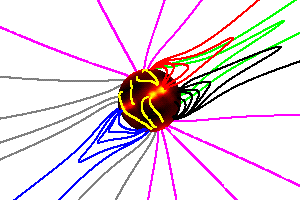| Helmet Streamers and the Magnetic
Structure of the Corona |
 Magnetic field lines from a computer simulation performed in
advance of the
October 24, 1995 solar eclipse,
to predict the structure of the solar corona.
Field line colors are arbitrary, colors on the
Sun's surface show the strength of the magnetic field
(yellow is largest). Click on image for full size
( 14K GIF).
Magnetic field lines from a computer simulation performed in
advance of the
October 24, 1995 solar eclipse,
to predict the structure of the solar corona.
Field line colors are arbitrary, colors on the
Sun's surface show the strength of the magnetic field
(yellow is largest). Click on image for full size
( 14K GIF).
The gas in the solar corona is at very high temperatures (typically 1-2 million
degrees Kelvin in most regions) so it is almost completely in a plasma
state (made up of charged particles, mostly protons and electrons).
Strong magnetic fields thread through the corona. Where these magnetic lines
of force are closed, the magnetic field is strong enough to trap
the solar plasma and keep it from escaping. Plasma accumulates
in these regions and forms the beautiful structures called helmet
streamers seen during solar eclipses.
Prominences are often situated beneath helmet streamers, and active
regions occur beneath streamers near the equator (sometimes called
active regions streamers). In some regions, the coronal magnetic
field cannot confine the plasma, and the plasma expands outward,
reaching supersonic velocities. Regions on the Sun with these
open magnetic field lines (which stretch far out into the solar system)
correspond to coronal holes and are the source of the solar wind, which
accelerates outward from the Sun and fills interplanetary space.
The electrons in the coronal hole plasma are typically cooler and
less dense than streamers,
and so they show up as dark regions in both X-rays and white light.
To learn more about the Sun and the solar system, visit
Windows to the Universe.
 Return to the Coronal Modeling Page
Return to the Coronal Modeling Page
 Magnetic field lines from a computer simulation performed in
advance of the
October 24, 1995 solar eclipse,
to predict the structure of the solar corona.
Field line colors are arbitrary, colors on the
Sun's surface show the strength of the magnetic field
(yellow is largest). Click on image for full size
( 14K GIF).
Magnetic field lines from a computer simulation performed in
advance of the
October 24, 1995 solar eclipse,
to predict the structure of the solar corona.
Field line colors are arbitrary, colors on the
Sun's surface show the strength of the magnetic field
(yellow is largest). Click on image for full size
( 14K GIF).